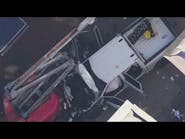Terrorism isn’t a new trend, but since the 1970s, it has been on the increase in the United States. First responders must train and prepare for terrorism or any acts of violence.
Materials and perpetrators
The weapon of choice for terrorism is explosives. Anyone can use explosives anywhere at any time. Everyday items that are found in most homes make up improvised explosive devices (IEDs) and require little technical knowledge to deploy. Trinitrotoluene (TNT), which costs as little as $1 per pound, is obtained easily.
Responders must maintain awareness of their surroundings and a high index of suspicion and understand the mindset of a terrorist attack and the mechanism of an explosion, to keep you safe and to increase the survivability of victims.
Risks everywhere
Every event or location can be the staging for an IED. Incident locations always are unsafe until trained personnel render them secured and safe. The old belief was that if there was one explosive device, there would be two, the initial one and the one to take out or harm first responders. The new view is that if there is one, there are many.
Someone who might appear to be a victim of an attack might be a suicide bomber who is waiting to detonate another device. Providers can help enhance surveillance and recognize an imminent hazard by taking steps to report a suspected individual to law enforcement.
Suicide bombers can come from any cultural or religious background. They often participate in months of indoctrination training. When ready for the mission, the indoctrinated can be in a “hypnotic state,” with some believing that the mission will open heaven’s gates. Most are men 17–23 years old.
Dissecting an explosion
There are two types of explosives: low explosives (LE) and high explosives (HE). Fireworks and black powder are examples of LE. Nitroglycerin, dynamite, C-4, ammonium nitrate/fuel oil (ANFO), TNT and triacetone triperoxide (TATP) are HE.
The term explosive train describes the chain of explosives that are used. A primary, such as a blasting cap, is extremely sensitive and dangerous. These don’t require a particular initiator or denominator to ignite. They respond to heat, friction, impact and spark.
Primary devices set off secondary devices and/or tertiary devices, such as ANFO. Homemade explosives (HME) combine precursor ingredients, including oxidizers and fuels.
First responders should utilize all of their senses, including smell, to detect an HME or IED. A sweet or fishy odor should raise one’s suspicion. They are common in peroxides, which are a highly explosive ingredient.
An explosion is the rapid expansion of matter that generates high pressure and temperatures that have several phases. Each phase of an explosion can produce a unique traumatic event that can have an effect on or to a victim. Most references talk about four: primary, secondary, tertiary and quaternary. I include a fifth: quinary.
The primary, or blast, phase creates an overpressure (pressure wave). Common injuries include blast lung, eardrum or eye rupture, and abdominal bleeding or perforation. Normal atmospheric pressure is 14.7 psi. Adding only 5 psi can rupture eardrums, another 30 can damage hollow organs, and 100 psi is 50 percent fatal.
Secondary blasts produce powerful blast waves behind the pressure front, to propel fragments and debris. These blasts can cause blunt and penetrating trauma.
Some confuse fragmentation with shrapnel. Fragmentation is pieces of the explosive device or container. Shrapnel only comes from items that are added to the bomb, i.e., nails and glass.
Tertiary injuries can occur when the body is thrown by the explosion and include fractures, traumatic amputations and internal injuries.
Quaternary blast injuries are burns or incapacitation from inhaled toxic fire gases.
The quinary phase contains a chemical, radioactive or biological component. This phase includes psychological trauma, including post-traumatic stress disorder and survival syndrome/guilt.
Confined spaces
First responders also must consider whether the device exploded in an open or confined space. A victim who is in a confined space will experience injuries from a reflected pressure wave that’s created once the initial blast wave hits an object and reflects backward. Even a small IED can be effective in a confined space, as was the case in the London subway bombings.
Understand and assess for hidden injuries. Even the slightest damage can be potentially lethal. Don’t hesitate to use torniquets to control bleeding and to rapidly cool any burns.

Richard Bossert
Richard Bossert is a retired operations chief for the Philadelphia Fire Department. He started in the fire/rescue services in 1970, volunteering for the Warminster, PA, Fire Department. He worked for three career fire departments: Chester, Bensalem and Philadelphia. Bossert became a certified EMT in 1973, then paramedic in 1980. He received a bachelor’s degree in pre-med from Pennsylvania State University in 1977 and a master’s degree in public safety administration from St. Joseph’s University in 2003.






